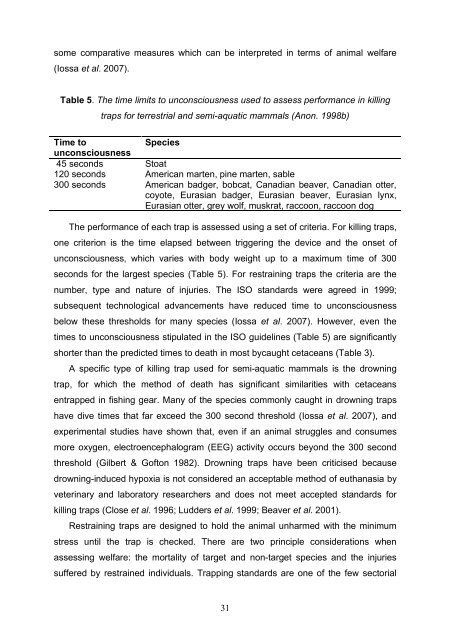The Animal Welfare Implications of Cetacean Deaths in Fisheries
The Animal Welfare Implications of Cetacean Deaths in Fisheries
The Animal Welfare Implications of Cetacean Deaths in Fisheries
Create successful ePaper yourself
Turn your PDF publications into a flip-book with our unique Google optimized e-Paper software.
some comparative measures which can be <strong>in</strong>terpreted <strong>in</strong> terms <strong>of</strong> animal welfare<br />
(Iossa et al. 2007).<br />
Table 5. <strong>The</strong> time limits to unconsciousness used to assess performance <strong>in</strong> kill<strong>in</strong>g<br />
traps for terrestrial and semi-aquatic mammals (Anon. 1998b)<br />
Time to<br />
Species<br />
unconsciousness<br />
45 seconds Stoat<br />
120 seconds American marten, p<strong>in</strong>e marten, sable<br />
300 seconds American badger, bobcat, Canadian beaver, Canadian otter,<br />
coyote, Eurasian badger, Eurasian beaver, Eurasian lynx,<br />
Eurasian otter, grey wolf, muskrat, raccoon, raccoon dog<br />
<strong>The</strong> performance <strong>of</strong> each trap is assessed us<strong>in</strong>g a set <strong>of</strong> criteria. For kill<strong>in</strong>g traps,<br />
one criterion is the time elapsed between trigger<strong>in</strong>g the device and the onset <strong>of</strong><br />
unconsciousness, which varies with body weight up to a maximum time <strong>of</strong> 300<br />
seconds for the largest species (Table 5). For restra<strong>in</strong><strong>in</strong>g traps the criteria are the<br />
number, type and nature <strong>of</strong> <strong>in</strong>juries. <strong>The</strong> ISO standards were agreed <strong>in</strong> 1999;<br />
subsequent technological advancements have reduced time to unconsciousness<br />
below these thresholds for many species (Iossa et al. 2007). However, even the<br />
times to unconsciousness stipulated <strong>in</strong> the ISO guidel<strong>in</strong>es (Table 5) are significantly<br />
shorter than the predicted times to death <strong>in</strong> most bycaught cetaceans (Table 3).<br />
A specific type <strong>of</strong> kill<strong>in</strong>g trap used for semi-aquatic mammals is the drown<strong>in</strong>g<br />
trap, for which the method <strong>of</strong> death has significant similarities with cetaceans<br />
entrapped <strong>in</strong> fish<strong>in</strong>g gear. Many <strong>of</strong> the species commonly caught <strong>in</strong> drown<strong>in</strong>g traps<br />
have dive times that far exceed the 300 second threshold (Iossa et al. 2007), and<br />
experimental studies have shown that, even if an animal struggles and consumes<br />
more oxygen, electroencephalogram (EEG) activity occurs beyond the 300 second<br />
threshold (Gilbert & G<strong>of</strong>ton 1982). Drown<strong>in</strong>g traps have been criticised because<br />
drown<strong>in</strong>g-<strong>in</strong>duced hypoxia is not considered an acceptable method <strong>of</strong> euthanasia by<br />
veter<strong>in</strong>ary and laboratory researchers and does not meet accepted standards for<br />
kill<strong>in</strong>g traps (Close et al. 1996; Ludders et al. 1999; Beaver et al. 2001).<br />
Restra<strong>in</strong><strong>in</strong>g traps are designed to hold the animal unharmed with the m<strong>in</strong>imum<br />
stress until the trap is checked. <strong>The</strong>re are two pr<strong>in</strong>ciple considerations when<br />
assess<strong>in</strong>g welfare: the mortality <strong>of</strong> target and non-target species and the <strong>in</strong>juries<br />
suffered by restra<strong>in</strong>ed <strong>in</strong>dividuals. Trapp<strong>in</strong>g standards are one <strong>of</strong> the few sectorial<br />
31
















